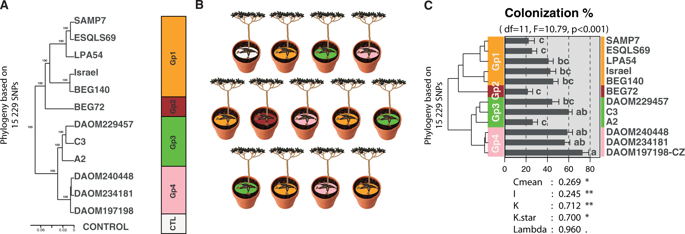Our official English website, www.x-mol.net, welcomes your
feedback! (Note: you will need to create a separate account there.)
Genetic variation and evolutionary history of a mycorrhizal fungus regulate the currency of exchange in symbiosis with the food security crop cassava.
The ISME Journal ( IF 10.8 ) Pub Date : 2020-02-17 , DOI: 10.1038/s41396-020-0606-6 Romain Savary 1, 2 , Cindy Dupuis 1 , Frédéric G Masclaux 1, 3 , Ivan D Mateus 1 , Edward C Rojas 1, 4 , Ian R Sanders 1
The ISME Journal ( IF 10.8 ) Pub Date : 2020-02-17 , DOI: 10.1038/s41396-020-0606-6 Romain Savary 1, 2 , Cindy Dupuis 1 , Frédéric G Masclaux 1, 3 , Ivan D Mateus 1 , Edward C Rojas 1, 4 , Ian R Sanders 1
Affiliation

|
Most land plants form symbioses with arbuscular mycorrhizal fungi (AMF). Diversity of AMF increases plant community productivity and plant diversity. For decades, it was known that plants trade carbohydrates for phosphate with their fungal symbionts. However, recent studies show that plant-derived lipids probably represent the most essential currency of exchange. Understanding the regulation of plant genes involved in the currency of exchange is crucial to understanding stability of this mutualism. Plants encounter many different AMF genotypes that vary greatly in the benefit they confer to plants. Yet the role that fungal genetic variation plays in the regulation of this currency has not received much attention. We used a high-resolution phylogeny of one AMF species (Rhizophagus irregularis) to show that fungal genetic variation drives the regulation of the plant fatty acid pathway in cassava (Manihot esculenta); a pathway regulating one of the essential currencies of trade in the symbiosis. The regulation of this pathway was explained by clearly defined patterns of fungal genome-wide variation representing the precise fungal evolutionary history. This represents the first demonstrated link between the genetics of AMF and reprogramming of an essential plant pathway regulating the currency of exchange in the symbiosis. The transcription factor RAM1 was also revealed as the dominant gene in the fatty acid plant gene co-expression network. Our study highlights the crucial role of variation in fungal genomes in the trade of resources in this important symbiosis and also opens the door to discovering characteristics of AMF genomes responsible for interactions between AMF and cassava that will lead to optimal cassava growth.
中文翻译:

菌根真菌的遗传变异和进化史调节与粮食安全作物木薯共生的交换货币。
大多数陆地植物与丛枝菌根真菌(AMF)形成共生。 AMF 的多样性提高了植物群落生产力和植物多样性。几十年来,人们都知道植物与其真菌共生体用碳水化合物交换磷酸盐。然而,最近的研究表明,植物来源的脂质可能代表了最重要的交换货币。了解交换货币中涉及的植物基因的调控对于理解这种互利共生的稳定性至关重要。植物会遇到许多不同的 AMF 基因型,这些基因型给植物带来的益处差异很大。然而,真菌遗传变异在货币调节中所发挥的作用并没有受到太多关注。我们使用一种 AMF 物种(不规则根霉)的高分辨率系统发育来表明真菌遗传变异驱动木薯(Manihot esculenta)植物脂肪酸途径的调节;调节共生贸易的基本货币之一的途径。该途径的调节可以通过代表精确的真菌进化历史的真菌全基因组变异的明确定义模式来解释。这代表了 AMF 遗传学与调节共生交换货币的重要植物途径重新编程之间的联系。转录因子RAM1也被揭示为脂肪酸植物基因共表达网络中的显性基因。我们的研究强调了真菌基因组变异在这一重要共生关系中资源贸易中的关键作用,也为发现负责 AMF 和木薯之间相互作用的 AMF 基因组特征打开了大门,从而导致木薯最佳生长。
更新日期:2020-02-17
中文翻译:

菌根真菌的遗传变异和进化史调节与粮食安全作物木薯共生的交换货币。
大多数陆地植物与丛枝菌根真菌(AMF)形成共生。 AMF 的多样性提高了植物群落生产力和植物多样性。几十年来,人们都知道植物与其真菌共生体用碳水化合物交换磷酸盐。然而,最近的研究表明,植物来源的脂质可能代表了最重要的交换货币。了解交换货币中涉及的植物基因的调控对于理解这种互利共生的稳定性至关重要。植物会遇到许多不同的 AMF 基因型,这些基因型给植物带来的益处差异很大。然而,真菌遗传变异在货币调节中所发挥的作用并没有受到太多关注。我们使用一种 AMF 物种(不规则根霉)的高分辨率系统发育来表明真菌遗传变异驱动木薯(Manihot esculenta)植物脂肪酸途径的调节;调节共生贸易的基本货币之一的途径。该途径的调节可以通过代表精确的真菌进化历史的真菌全基因组变异的明确定义模式来解释。这代表了 AMF 遗传学与调节共生交换货币的重要植物途径重新编程之间的联系。转录因子RAM1也被揭示为脂肪酸植物基因共表达网络中的显性基因。我们的研究强调了真菌基因组变异在这一重要共生关系中资源贸易中的关键作用,也为发现负责 AMF 和木薯之间相互作用的 AMF 基因组特征打开了大门,从而导致木薯最佳生长。











































 京公网安备 11010802027423号
京公网安备 11010802027423号